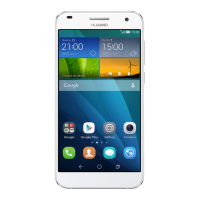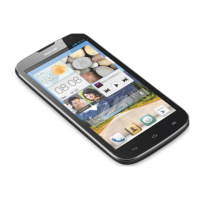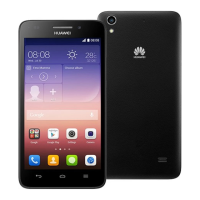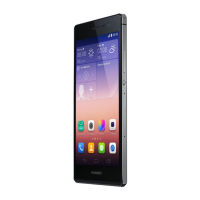Do you have a question about the Huawei Ascend G510 and is the answer not in the manual?
Explains symbols used to indicate useful and important information in the manual.
Diagram and labels identifying the physical components and buttons of the Huawei Ascend G510.
Step-by-step instructions for correctly inserting the SIM card into the phone.
Guide on how to insert a microSD card to expand the phone's storage capacity.
Instructions for properly installing the phone's battery into its compartment.
Procedure for connecting the charger and understanding battery indicator lights.
Steps for powering the phone on, off, restarting, and initial setup for first-time use.
Explains fundamental touch gestures like touch, drag, flick, and pinch for device interaction.
Methods to secure and access the phone's display, including screen lock options.
Overview of the home screen layout, status bar, display area, and common status icons.
How to navigate between multiple home screens using flicking or thumbnails.
Instructions for capturing screen content.
Managing automatic screen orientation based on device tilt.
How to open and use the notification panel for quick access to settings and notifications.
Launching applications, switching between them, and viewing recently used applications.
Entering text using the onscreen keyboard and composing messages.
Details on using the Android keyboard, voice input, and text editing operations.
How to change the default input method and configure keyboard settings.
Guides on changing the phone's visual theme and setting custom wallpapers.
How to add, delete, and move application icons and widgets on home screens.
Creating and managing folders for apps, and customizing the Me Widget.
Rearranging home screens and customizing quick access shortcuts in the notification panel.
Managing phone profiles and configuring various sound and notification tones.
Adjusting text size and screen brightness for better readability and comfort.
Setting up various screen lock methods including face unlock, pattern, PIN, and password.
Features for smart dialing, answering, rejecting, and viewing call logs.
Operations during a call, including hold, speakerphone, mute, and making conference calls.
Making emergency calls and using services like call forwarding, call waiting, and voicemail.
Creating, searching, copying, importing, and exporting contacts for easy management.
Adding contacts to favorites, deleting contacts, and joining duplicate entries.
Methods for sharing contacts and creating/managing contact groups for communication.
Instructions for sending text and multimedia messages, and replying to conversations.
Features for searching, copying, forwarding, and locking important messages.
Procedures for deleting individual messages or entire conversation threads.
Customizing message tones, signatures, and other related settings.
How to navigate websites, manage bookmarks, and set the browser's home page.
Adding, accessing, and editing bookmarks for frequently visited websites.
Steps to clear the browsing history to protect privacy and free up space.
Guides on adding POP3, IMAP, and Exchange email accounts to the device.
Switching between accounts, sending emails, and composing messages with attachments.
Reading emails, replying, forwarding, deleting, and removing email accounts from the device.
Using the camera for photos, videos, panoramic shots, and managing camera settings.
Viewing photos and videos, playing slideshows, and editing media files.
Editing photos (cropping, rotating, effects) and setting images as wallpaper.
Listening to music, copying songs, creating playlists, and setting songs as ringtones.
Connecting to the internet using mobile data or Wi-Fi networks.
Sharing phone's data via USB tethering or as a Wi-Fi hotspot.
Monitoring and controlling mobile data usage, setting limits, and viewing application data consumption.
Turning on Bluetooth, pairing devices, and transferring files wirelessly.
Using DLNA for media sharing and Android Beam for quick data transfer via NFC.
Connecting the phone to a computer via USB for file transfer (MTP, PTP).
Creating folders, searching for files, copying, moving, and deleting files.
Compressing/decompressing files and renaming files for better organization.
Creating shortcuts for files/folders and checking phone's storage memory status.
Obtaining applications from stores and viewing installed apps on the phone.
Removing unwanted applications and clearing application cache to free up memory.
Sending and checking emails using the Gmail application.
Using Google Talk for chat and Google Maps for navigation and location services.
Watching videos on YouTube and downloading apps from the Play Store.
Creating, viewing, and synchronizing calendar events and configuring settings.
Using the clock for timekeeping, setting alarms, and configuring alarm settings.
Using calculator, taking notes, and checking weather information for various cities.
Searching for stations and listening to FM radio using the headset.
Adding, deleting, and synchronizing accounts (contacts, emails, events) with the web.
Modifying synchronization settings for various accounts and data types.
Turning airplane mode on/off and configuring various sound and tone settings.
Adjusting display settings, enabling power saving mode, and setting date and time.
Changing system language and modifying location service settings.
Managing fast boot, restoring factory settings, and performing online software updates.
Turning on or off preset or installed accessibility features for enhanced usability.
Answers to common questions about freeing memory, saving battery, and importing contacts.
FAQs on setting ringtones, screen unlock patterns, input methods, and call screen return.
Copyright information, trademarks, and permissions related to the product and manual.
Information on software limitations, network dependencies, and general disclaimers.
Details regarding third-party software compatibility, warranty, and support.
Information on export regulations, licenses, and the company's privacy policy.
Explains symbols used to indicate useful and important information in the manual.
Diagram and labels identifying the physical components and buttons of the Huawei Ascend G510.
Step-by-step instructions for correctly inserting the SIM card into the phone.
Guide on how to insert a microSD card to expand the phone's storage capacity.
Instructions for properly installing the phone's battery into its compartment.
Procedure for connecting the charger and understanding battery indicator lights.
Steps for powering the phone on, off, restarting, and initial setup for first-time use.
Explains fundamental touch gestures like touch, drag, flick, and pinch for device interaction.
Methods to secure and access the phone's display, including screen lock options.
Overview of the home screen layout, status bar, display area, and common status icons.
How to navigate between multiple home screens using flicking or thumbnails.
Instructions for capturing screen content.
Managing automatic screen orientation based on device tilt.
How to open and use the notification panel for quick access to settings and notifications.
Launching applications, switching between them, and viewing recently used applications.
Entering text using the onscreen keyboard and composing messages.
Details on using the Android keyboard, voice input, and text editing operations.
How to change the default input method and configure keyboard settings.
Guides on changing the phone's visual theme and setting custom wallpapers.
How to add, delete, and move application icons and widgets on home screens.
Creating and managing folders for apps, and customizing the Me Widget.
Rearranging home screens and customizing quick access shortcuts in the notification panel.
Managing phone profiles and configuring various sound and notification tones.
Adjusting text size and screen brightness for better readability and comfort.
Setting up various screen lock methods including face unlock, pattern, PIN, and password.
Features for smart dialing, answering, rejecting, and viewing call logs.
Operations during a call, including hold, speakerphone, mute, and making conference calls.
Making emergency calls and using services like call forwarding, call waiting, and voicemail.
Creating, searching, copying, importing, and exporting contacts for easy management.
Adding contacts to favorites, deleting contacts, and joining duplicate entries.
Methods for sharing contacts and creating/managing contact groups for communication.
Instructions for sending text and multimedia messages, and replying to conversations.
Features for searching, copying, forwarding, and locking important messages.
Procedures for deleting individual messages or entire conversation threads.
Customizing message tones, signatures, and other related settings.
How to navigate websites, manage bookmarks, and set the browser's home page.
Adding, accessing, and editing bookmarks for frequently visited websites.
Steps to clear the browsing history to protect privacy and free up space.
Guides on adding POP3, IMAP, and Exchange email accounts to the device.
Switching between accounts, sending emails, and composing messages with attachments.
Reading emails, replying, forwarding, deleting, and removing email accounts from the device.
Using the camera for photos, videos, panoramic shots, and managing camera settings.
Viewing photos and videos, playing slideshows, and editing media files.
Editing photos (cropping, rotating, effects) and setting images as wallpaper.
Listening to music, copying songs, creating playlists, and setting songs as ringtones.
Connecting to the internet using mobile data or Wi-Fi networks.
Sharing phone's data via USB tethering or as a Wi-Fi hotspot.
Monitoring and controlling mobile data usage, setting limits, and viewing application data consumption.
Turning on Bluetooth, pairing devices, and transferring files wirelessly.
Using DLNA for media sharing and Android Beam for quick data transfer via NFC.
Connecting the phone to a computer via USB for file transfer (MTP, PTP).
Creating folders, searching for files, copying, moving, and deleting files.
Compressing/decompressing files and renaming files for better organization.
Creating shortcuts for files/folders and checking phone's storage memory status.
Obtaining applications from stores and viewing installed apps on the phone.
Removing unwanted applications and clearing application cache to free up memory.
Sending and checking emails using the Gmail application.
Using Google Talk for chat and Google Maps for navigation and location services.
Watching videos on YouTube and downloading apps from the Play Store.
Creating, viewing, and synchronizing calendar events and configuring settings.
Using the clock for timekeeping, setting alarms, and configuring alarm settings.
Using calculator, taking notes, and checking weather information for various cities.
Searching for stations and listening to FM radio using the headset.
Adding, deleting, and synchronizing accounts (contacts, emails, events) with the web.
Modifying synchronization settings for various accounts and data types.
Turning airplane mode on/off and configuring various sound and tone settings.
Adjusting display settings, enabling power saving mode, and setting date and time.
Changing system language and modifying location service settings.
Managing fast boot, restoring factory settings, and performing online software updates.
Turning on or off preset or installed accessibility features for enhanced usability.
Answers to common questions about freeing memory, saving battery, and importing contacts.
FAQs on setting ringtones, screen unlock patterns, input methods, and call screen return.
Copyright information, trademarks, and permissions related to the product and manual.
Information on software limitations, network dependencies, and general disclaimers.
Details regarding third-party software compatibility, warranty, and support.
Information on export regulations, licenses, and the company's privacy policy.
| Display diagonal | 4.5 \ |
|---|---|
| Display resolution | 854 x 480 pixels |
| Processor frequency | 1.2 GHz |
| RAM capacity | 0.5 GB |
| Compatible memory cards | MicroSD (TransFlash) |
| Maximum memory card size | 32 GB |
| Internal storage capacity | 4 GB |
| Video recording | - |
| Front camera type | Single camera |
| Rear camera resolution (numeric) | 5 MP |
| Front camera resolution (numeric) | 0.3 MP |
| 2G standards | EDGE, GSM |
| 3G standards | HSPA, UMTS |
| Wi-Fi standards | 802.11b, 802.11g, Wi-Fi 4 (802.11n) |
| Bluetooth version | 2.1+EDR |
| 3G bands supported | 900, 2100 MHz |
| SIM card capability | Single SIM |
| 2G bands (primary SIM) | 850, 900, 1800, 1900 MHz |
| Mobile network generation | 3G |
| HDMI ports quantity | 0 |
| Headphone connectivity | 3.5 mm |
| Form factor | Bar |
| Product color | White |
| Platform | Android |
| Bundled software | Facebook, Twitter |
| Operating system installed | Android 4.1 |
| Battery capacity | 1750 mAh |
| Depth | 9.9 mm |
|---|---|
| Width | 67 mm |
| Height | 174 mm |
| Weight | 150 g |











